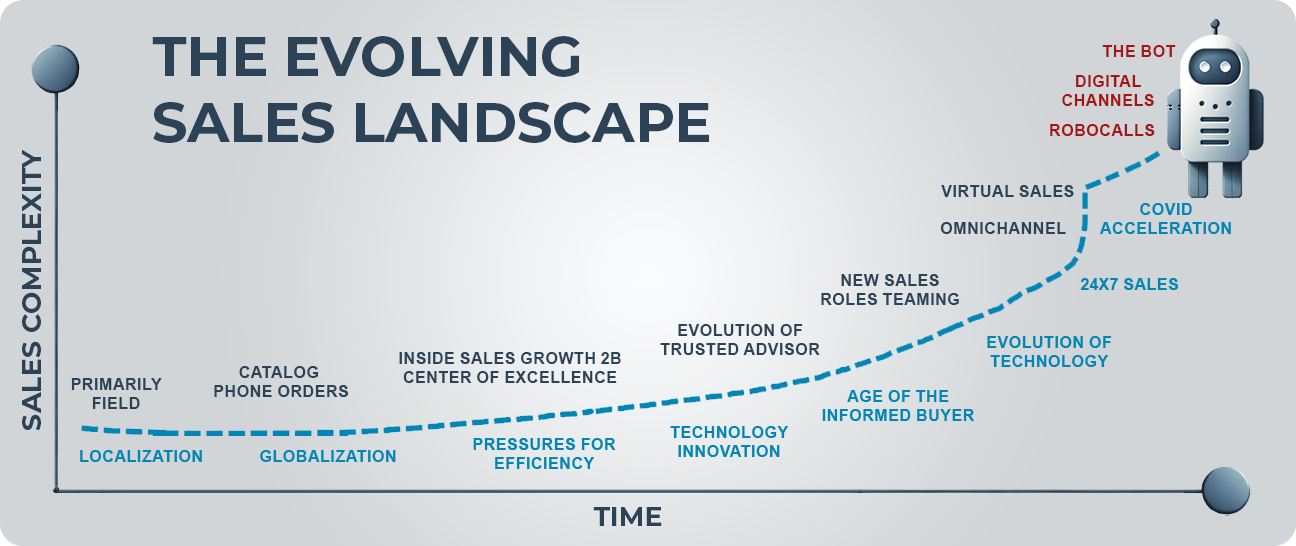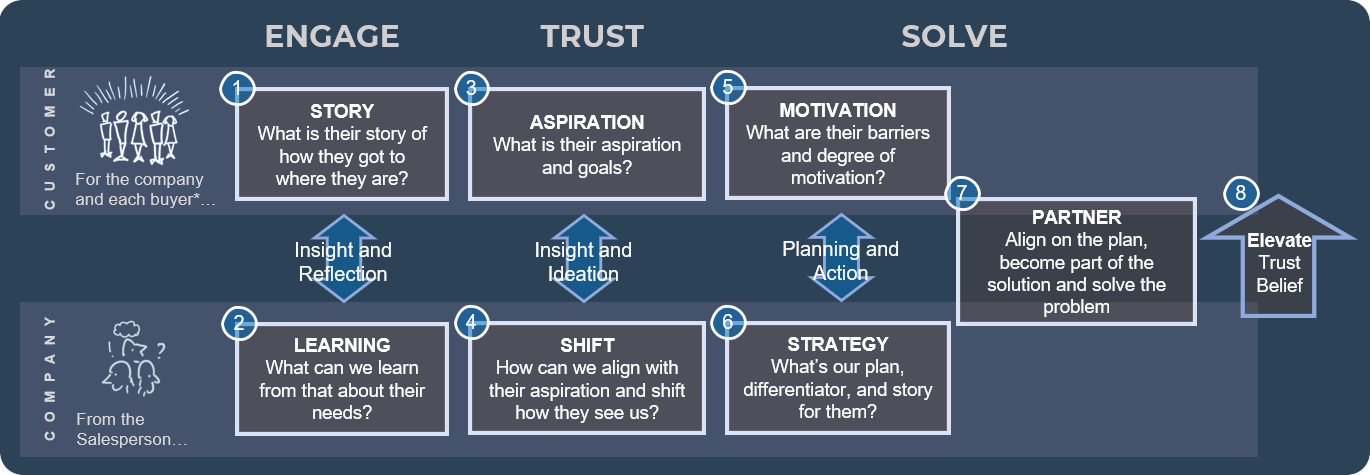Revolutionizing Sales Connections: Navigating the Modern Sales Landscape

I can’t recall in my lifetime that I’ve ever experienced so much change compressed into such a short period of time. It seems that the phrase “since the pandemic” has become ubiquitous when talking about habits, behaviors and how we engage with one another as a society. And it’s the same for sales. As I was preparing to speak at a conference on “Building a Modern Sales Structure, from KPIs and What Matters Most” I kept shifting my thinking to “what matters most”. You can build the best sales organization out there with well-defined roles and responsibilities from lead generation to close activities, but if you can’t figure out how to create a connection with your customer, it’s all for naught. In sales, we build CRM for insight, SPM to track and measure progress, we build in pipeline cadence discipline, and redesign the incentive program, but if your team doesn’t know how to create a connection with the customer, nothing else really matters other than to demonstrate you may not be getting the growth and outcomes that you have forecasted and expect.
Now that’s not to say those things are not important. In fact, they are critical to enable the team to do their work more effectively and to understand where and how to focus their sales efforts. However, it’s fundamental that they create a connection with their customer, even in a sales world where omnichannel has become table stakes for doing business, and bringing a more self-service B2C experience into the B2B sales world has permeated the sales strategy coming directly from the C-Suite. I continue to engage with our clients, who are mostly focused on solving their greatest sales challenges centered around growth. Despite restructuring teams, adding new roles, and altering incentive plans, many still do not achieve the expected results. And that’s because today it’s all about the engagement model with the buyer. From the first contact that may come from marketing to the first conversation, how we connect and what we say must change to respond to the changing dynamics of how people connect with one another and communicate in a world where our now modern methods of communication have dramatically changed behaviors, habits and expectations.
If we take the most simplistic view of the evolving sales process, here’s a few from my perspective of what’s happened over time, and the big drivers behind the changing sales landscape:

As people lived in their local region, they engaged with salespeople face-to-face, or “in the field”. From the traveling salesperson bringing their wares across a region to people going to shops and open-air markets, sales was conducted with the engagement of two or more people engaging in a transaction. As technology evolved, and people had the means to engage in commerce outside of their local region, globalization and pressures for efficiency became key drivers for the growth of inside sales, which was the fastest growing sales role across companies through 2019. At the same time, marketing became more savvy, as companies developed more sophisticated websites and engaged in outbound marketing with more information and messaging than had previously been available to a buying community. With the pandemic pushing people out of the office and into their homes and conferences and events where buyers and salespeople would connect being canceled for more than 2 years, omnichannel became table stakes, virtual communication became a new habit from business platforms like Zoom to personal platforms like FaceTime. From my 8-year-old to my 89-year-old dad, virtual communication has become commonplace. Now, with AI, we are asking ourselves once again, how is this going to change the landscape of sales, and how will buyers and sellers engage?
Here’s what we know: where the process is slowing down and why. Companies are doing a much better job at prospecting and demand generation than they have in the past, and the idea of salesperson as a trusted advisor has now been around for a long time. So, what’s impeding the process? Why is it that as much as your salespeople are engaging and educating their prospective and current buyers, there is a long wait time filled with impeding factors (I’m sure you can think of many right now in your business) that is slowing down the decision to finalize a purchase. The salesperson doesn’t understand the core challenge and problem that their customers are solving for, and they don’t know how to have the right conversation to create a connection with their buyer from the start.

So where does an organization start, and how do they create the right connection with the customer? Let’s take a look at this from the perspective of the sales process, and then we’ll shift over to what people need to do differently in order to create connections in a very noisy and complex world where buyers are continuously being distracted and pulled in different directions as companies and individuals work to get their time and attention and create an emotional connection as one method to “keep them coming back”.
Buyer Engagement – First Gate.
This is the stage where your company is building marketing campaigns, planning events or an account plan, all with the intent of getting the attention of the buyer and creating that first level of engagement with them where the buyer is interested in learning more. At this stage, it is critical to understand in the B2B world not only what the company may need from you, but what is it that the buyer needs to make them more successful on their job, and how does your product and service help them to meet this need? Some new discovery is needed at this point. It’s not about your products and services, it is really all about them. What are the big obstacles that they are facing on the job? What are the biggest challenges that they have, and what are their objectives and goals? What does “great look like” from the perspective of the buyer, and how can your company help? This is a whole new way of thinking and engaging and requires companies to change their perspective. It’s not about “why your company is better” it’s really about how you can help them meet their objectives and goals. This starts with a practical approach to reassessing your target market demographics. How is the industry you are serving evolving and changing? What big challenges are they facing? What is the role of your buyer, and how are their expectations changing? In this new online world where people are continuously seeking information, your company having a voice in their challenges, providing ideation and even a forum where their challenges can be discussed is key to engagement and gaining attention from the start. Getting testimonials and referrals from your existing customers also makes a difference. Marketing can build simple case studies and other proof sources of the work that you do and the results that you have achieved for other customers that you serve. It’s also a great opportunity to engage with your sales leadership for some thought leadership on the customers that you serve, and this can be a great partnering exercise between sales and marketing.
Establishing Trust – Second Gate.
As a salesperson begins to engage, their entire talk track must change. This is where you begin to build credibility by changing the conversation. We call this having a discovery conversation that leads you into understanding the story of the buyer and their company, and this leads you into the next phase of solving their problem. Once you have established trust, they expect if you come to them with a solution, you are going to be able to solve the problem with it. Finally, at this stage your organization must be both accessible and responsive. It has been drilled into the DNA of a salesperson to be responsive. We have SLA’s and metrics on how quickly to respond to a call for example, however that is very different from being accessible. Accessible means that the salesperson can relate to the buyer to the point that the buyer is comfortable asking for guidance and real help. This takes time and practice and ensuring that your sales team members are building an online social presence that reflects their experience, knowledge and credibility is key. This may require instructing your team to professionalize their online presence. If they don’t want their boss or their buyer to see it, then it probably doesn’t belong online for public viewing.
Problem Solved – Third Gate.
The last gate is the assurance that you have solved their problem. If your salesperson can solve the problem confidently and stand behind their offer, they will win the business. This doesn’t necessarily mean you can solve all their problems. But if you can confidently address their top concerns and issues, that is the goal.

Although the steps sound easy, it requires a new way of thinking, practice and a lot of up front discovery and research so that a salesperson knows what they are working to accomplish on behalf of their buyer’s needs. We call this the Engage, Trust, Solve method at SalesGlobe. And I’m here to tell you, it really works. You can try it at home and you can try it at work. From interpersonal to business solutions, you will find that this method opens more doors and allows you to build better relationships. And it all starts with… having a discovery conversation!
Following is an overview of the method that you should feel free to tailor to the needs of your own sales organization and buyer ecosystem.

It all starts with understanding the story of your customer, the problems they are solving for, and what their vision of great looks like as they think about partnering with your company to buy your products and services. It requires a change in mindset, and a change in the conversation. And I am here to tell you that no matter how good the technology is out there, and how great AI is in helping answer many questions that people have and the assistance it can give to them in their work, it is still not the same as the human connection, and at least won’t be in the foreseeable future. As a salesperson and sales leader working in an ever growing competitive and challenging sales environment, give yourself an opportunity to change the conversation and Engage, Trust and Solve! You have nothing to lose, and new opportunities to gain.

Transform your sales strategy with a program crafted for your team’s unique challenges. Our Engage, Trust, Solve Virtual Boot Camp is personalized to fit your company, providing tools and insights that lead to real growth.
Don’t wait to elevate your sales—reach out now to revolutionize your approach.

Chief Operating Officer and Partner at SalesGlobe
She hosts the podcast, “Riding the Big Wheel,” a platform for women in leadership to share their personal and professional stories and insights.
“We elevate your team’s altitude and new thinking to develop fresh perspective, ideas, and initiatives.”



